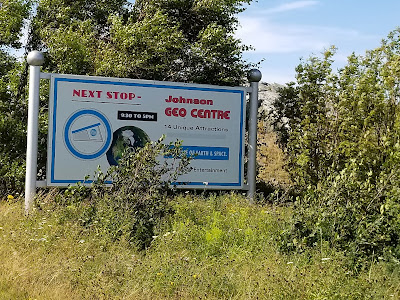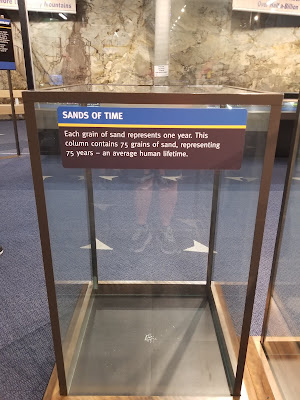#51 The Geo Center and the Cathedral
Monday September 2, 2019
Derrille and I went
to tour the Johnson Geo Center located on the west side of Signal Hill. The two story building was constructed right
into the hill itself. Each floor has extremely
high ceilings.
A small
exhibit of Coral and Sponges has a niche on the entry floor. An
elevator takes you down to the exhibit.
It advertises “underground” but it is really just a lower level.
You follow arrows on
the floor to exhibits on our planet, the province, the people and the future.
The story begins with Our Planet.
The Water Cycle begins the process.
The displays describes the various kinds of rocks and how they are formed.
Looking at the rocks reminded me of my geology classes and tickled some part of my brain to release some long forgotten knowledge stored there.
Earthquake information and their effect on rocks are shown.
Check out the sand
models that compares the age of the earth and a human lifetime. The 1st column went from the ceiling to the floor. It contains about 4,550,000,000 grains of sand representing the age of the earth. It is really 199 feet tall and contains 72 tons of sand. The 2nd column contains about 65,000,000 grains of sand, representing the number of years since the extinction of the dinosaurs. The 3rd column contains about 9,000 grains of sand representing the number of years since Signal Hill was last covered by glaciers. The 4th column contains 75 grains of sand representing 75 years, and average human lifetime.
Another time line shows the time in epochs
and periods. Humans are a tiny spot at
the end.
In the Province exhibits they look at how studying the rocks of Newfoundland and Labrador have helped in decoding the story of our Earth.
One section talks about Labrador: An ancient land. Round displays explain the kinds of rock.
A second section looks at Newfoundland: a younger land and the Birth of the Atlantic Ocean. This block of granite is polished on one side to show the large pink crystals.
I liked the way they described the Supercontinent and how it broke apart, then evolved to our current continents. We have seen this is other places too. Again it was nice to recognize places and information we have seen before.
This led into the Birth of the Atlantic Ocean.
I really liked this exhibit too. You pressed a button and the fossil on the rock wall would be highlighted.
The center challenges
you to find the 150 fossils in this cast wall.
Glacier section shows
a video. I took photos from the video to
show a big iceberg, and all the rocks in the bay were caused by ice age
erosion.
This Inukshuk welcomes you the People exhibit that focus on how the land and sea provide natural resources to shape the lives of the people who live here.
It talks about the
movement of humans out of Africa and across the planet. I found the skull collection
interesting.
The discovery of fire and the building of civilizations followed.
With technology and more people comes more
waste. This garbage display can help
remind us that taking care of waste disposal is important so it doesn’t affect
our groundwater adversely for years.
The last area looked
at our Future and Space.
You exit the center
by the Great Rock Wall. This is actual rock
of Signal Hill that has existed for over half a billion years ago and against
which the center was built. The signs
say: 300 million before the first dinosaurs, 350 million years before the
Atlantic Ocean, 450 million years before the Rocky Mountains.
These stains are
caused by water seeping through rock fractures.
The Hibernia oil rig looks huge. The man next to us in Argentia lives in the RV Park and works on the docks building another huge oil rig.
The SeaRose FPSO is a
floating rig for production, storage and offloading of oil.
This is St. John’s Harbour. I found it interesting.
An exhibit of the
Titanic looked identical to the one we saw in Twillingate. I had only photographed the “truth”
parts. Here is what a couple of panels
look like.
The diorama of the
ship and the iceberg added a sense of what the Titanic encountered.
The information was a lot to hard to digest,
but we really enjoyed this stop.
The beautiful Basilica Cathedral of St. John
the Baptist ranks as a Canadian Parks Service Historic Site. The double spires
of the church piece the horizon and are easily seen. The Romanesque cathedral was consecrated in
1855. As we drove in the parking lot,
many well-dressed people streamed out of church. Derrille convinced me to go in anyway. Apparently the funeral of a prominent man had
just concluded and this was the end of the people who attended. Father was closing
the door to protect against the wind; he said “come on in and look around”.
The ornate ceiling matched
the ornate seating provided on the altar, and the ornate lectern.
As you enter the church, the confessionals with statues at the end of the hall were on either side of the main aisle.
The Stations of Cross
looked like this and were affixed to the pillars facing the pews. You can see them in a photo above.
The altar sat over a
statue of Christ before burial. Golden
lighting enhanced the back of the altar with St. John the Baptist.
The side altars held statues of Mary and the Sacred Heart.
The side pews off the
altar that form the cross in this type of architecture looked very bare. However, a
nativity scene behind glass filled an area on one side, and our Lady of Lourdes
filled the other side.
The area that makes
up the 4 corners of the Romanesque cross design also hold the four evangelists: Mark, Matthew, Luke and John.
Several places around
the church plaques like this one honor priests, bishops and other people
important to this church. I don’t think
I have seen this done in the states.
The church contains
28 large and 35 smaller stain glass windows.
This is the largest collection of stain glass windows in
Newfoundland. Most were installed
between 1857 and 1905. I was glad we were able to see this beautiful Cathedral.
Time has traveled
quickly and tomorrow we head for Argentia and the ferry back to Nova Scotia.
Our trip to Newfoundland/Labrador gave us many wonderful memories.









































































































No comments:
Post a Comment